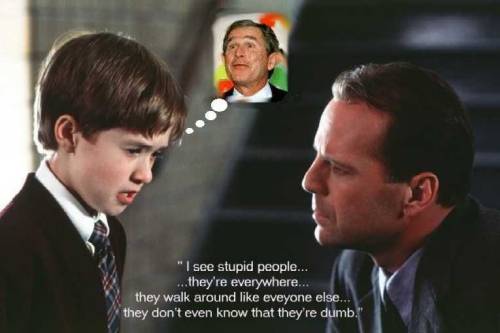I CAN FLY. WHO’LL JUMP OFF THIS BUILDING WITH ME?
Kurt Scudder sent this to me. We were having a discussion. His covering comment explains. It's a long one, but well worth your read.
[Hi George, I'm sorry it's taken me so long to get back to you after the last Spokane FFRF meeting. We talked about whether truth had selective advantage. I argued that, at least in one narrow sense, it did not. I've attached an HTML copy of a ten-year-old article from Skeptical Inquirer called "The Belief Engine". Give it a read, and let's discuss the idea further. Best Regards --Kurt Scudder]The Belief Engine
Our brains and nervous systems constitute a belief-generating machine, a system that evolved to assure not truth, logic, and reason, but survival. The belief engine has seven major components.
The following beliefs are strongly held by large numbers of people. Each of them has been hotly disputed by others:
Through hypnosis, one can access past lives.
Horoscopes provide useful information about the future.
Spiritual healing sometimes succeeds where conventional medicine fails.
A widespread, transgenerational Satanic conspiracy is afoot in society.
Certain gifted people have been able to use their psychic powers to help police solve crimes.
We can sometimes communicate with others via mental telepathy.
Some people have been abducted by UFOs and then returned to earth.
Elvis lives.
Vitamin C can ward off or cure the common cold.
Immigrants are stealing our jobs.
Certain racial groups are intellectually inferior.
Certain racial groups are athletically superior, at least in some specific sports.
Crime and violence are linked to the breakdown of the traditional family.
North Korea's developing nuclear capability poses a threat to world peace.
Despite high confidence on the part of both believers and disbelievers, in most instances, neither side has much—if any—objective evidence to back its position. Some of these beliefs, such as telepathy and astrology, stand in contradiction to the current scientific worldview and are therefore considered by many scientists to be "irrational." Others are not at all inconsistent with science, and whether or not they are based in fact, no one would consider them to be irrational.
Nineteenth-century rationalists predicted that superstition and irrationality would be defeated by universal education. However, this has not happened. High literacy rates and universal education have done little to decrease such belief, and poll after poll indicates that a large majority of the public believe in the reality of "occult" or "paranormal" or "supernatural" phenomena. Why should this be so? Why is it that in this highly scientific and technological age superstition and irrationality abound?
It is because our brains and nervous systems constitute a belief-generating machine, an engine that produces beliefs without any particular respect for what is real or true and what is not. This belief engine selects information from the environment, shapes it, combines it with information from memory, and produces beliefs that are generally consistent with beliefs already held. This system is as capable of generating fallacious beliefs as it is of generating beliefs that are in line with truth. These beliefs guide future actions and, whether correct or erroneous, they may prove functional for the individual who holds them. Whether or not there is really a Heaven for worthy souls does nothing to detract from the usefulness of such a belief for people who are searching for meaning in life.
Nothing is fundamentally different about what we might think of as "irrational" beliefs—they are generated in the same manner as are other beliefs. We may not have an evidential basis for belief in irrational concepts, but neither do we have such a basis for most of our beliefs. For example, you probably believe that brushing your teeth is good for you, but it is unlikely that you have any evidence to back up this belief, unless you are a dentist. You have been taught this, it makes some sense, and you have never been led to question it.
If we were to conceptualize the brain and nervous system as a belief engine, it would need to comprise several components, each reflecting some basic aspect of belief generation. Among the components, the following units figure importantly:
The Learning Unit
The learning unit is the key to understanding the belief engine. It is tied to the physical architecture of the brain and nervous system; and by its very nature, we are condemned to a virtually automatic process of magical thinking. "Magical thinking" is the interpreting of two closely occurring events as though one caused the other, without any concern for the causal link. For example, if you believe that crossing your fingers brought you good fortune, you have associated the act of finger-crossing with the subsequent welcome event and imputed a causal link between the two.
Our brain and nervous system have evolved over millions of years. It is important to recognize that natural selection does not select directly on the basis of reason or truth; it selects for reproductive success. Nothing in our cerebral apparatus gives any particular status to truth. Consider a rabbit in the tall grass, and grant for a moment a modicum of conscious and logical intellect to it. It detects a rustling in the tall grass, and having in the past learned that this occasionally signals the presence of a hungry fox, the rabbit wonders if there really is a fox this time or if a gust of wind caused the grass to rustle. It awaits more conclusive evidence. Although motivated by a search for truth, that rabbit does not live long. Compare the late rabbit to the rabbit that responds to the rustle with a strong autonomic nervous-system reaction and runs away as fast as it can. It is more likely to live and reproduce. So, seeking truth does not always promote survival, and fleeing on the basis of erroneous belief is not always such a bad thing to do. However, while this avoidance strategy may succeed in the forest, it may be quite dangerous to pursue in the nuclear age.
The learning unit is set up in such a way as to learn very quickly from the association of two significant events—such as touching a hot stove and feeling pain. It is set up so that significant pairings produce a lasting effect, while nonpairings of the same two events are not nearly so influential. If a child were to touch a stove once and be burned, then if the child were to touch it again without being burned, the association between pain and stove would not automatically be unlearned. This basic asymmetry—pairing of two stimuli has an important effect, while presenting the stimuli unpaired (that is, individually) has a much lesser effect—is important for survival.
This asymmetry in learning also underlies much of the error that colors our thinking about events that occur together from time to time. Humans are very poor at accurately judging the relationship between events that only sometimes co-occur. For example, if we think of Uncle Harry, and then he telephones us a few minutes later, this might seem to demand some explanation in terms of telepathy or precognition. However, we can only properly evaluate the co-occurrence of these two events if we also consider the number of times that we thought of Harry and he did not call, or we did not think of him but he called anyway. These latter circumstances—these nonpairings—have little impact on our learning system. Because we are overly influenced by pairings of significant events, we can come to infer an association, and even a causal one, between two events even if there is none. Thus, dreams may correspond with subsequent events only every so often by chance, and yet this pairing may have a dramatic effect on belief. Or we feel a cold coming on, take vitamin C, and then when the cold does not get to be too bad we infer a causal link. The world around us abounds with coincidental occurrences, some of which are meaningful but the vast majority of which are not. This provides a fertile ground for the growth of fallacious beliefs. We readily learn that associations exist between events, even when they do not. We are often led by co-occurring events to infer that the one that occurred first somehow caused the one that succeeded it.
We are all even more prone to error when rare or emotionally laden events are involved. We are always looking for causal explanations, and we tend to infer causality even when none exists. You might be puzzled or even distressed if you heard a loud noise in your living room but could find no source for it.
The Critical-Thinking Unit
The critical-thinking unit is the second component of the belief engine, and it is acquired -- acquired through experience and explicit education. Because of the nervous-system architecture that I have described, we are born to magical thinking. The infant who smiles just before a breeze causes a mobile above her head to move will smile again and again, as though the smile had magically caused the desired motion of the mobile. We have to labor to overcome such magical predisposition, and we never do so entirely. It is through experience and direct teaching that we come to understand the limits of our immediate magical intuitive interpretations. We are taught common logic by parents and teachers, and since it often serves us well, we use it where it seems appropriate. Indeed, the cultural parallel of this developmental process is the development of the formal method of logic and scientific inquiry. We come to realize that we cannot trust our automatic inferences about co-occurrence and causality.
We learn to use simple tests of reason to evaluate events around us, but we also learn that certain classes of events are not to be subjected to reason but should be accepted on faith. Every society teaches about transcendental things—ghosts, gods, bogeymen, and so on; and here we are often explicitly taught to ignore logic and accept such things on faith or on the basis of other people's experiences. By the time we are adults, we can respond to an event in either a logical, critical mode or in an experiential, intuitive mode. The events themselves often determine which way we will respond. If I were to tell you that I went home last night and found a cow in my living room, you would be more likely to laugh than to believe me, even though there is certainly nothing impossible about such an event. If, on the other hand, I were to tell you that I went into my living room and was startled by an eerie glow over my late grandfather's armchair, and that the room went cold, you may be less likely to disbelieve and more likely to perk up your ears and listen to the details, possibly suspending the critical acumen that you would bring to the cow story. Sometimes strong emotion interferes with the application of critical thought. Other times we are cleverly gulled.
Rationality is often at a disadvantage to intuitive thought. The late psychologist Graham Reed spoke of the example of the gambler's fallacy: Suppose you are observing a roulette wheel. It has come up black ten times in a row, and a powerful intuitive feeling is growing in you that it must soon come up red. It cannot keep coming up black forever. Yet your rational mind tells you that the wheel has no memory, that each outcome is independent of those that preceded. In such a case, the struggle between intuition and rationality is not always won by rationality.
Note that we can switch this critical thinking unit on or off. As I noted earlier, we may switch it off entirely if dealing with religious or other transcendental matters. Sometimes, we deliberately switch it on: "Hold it a minute, let me think this out," we might say to ourselves when someone tries to extract money from us for an apparently worthy cause.
The Yearning Unit
Learning does not occur in a vacuum. We are not passive receivers of information. We actively seek out information to satisfy our many needs. We may yearn to find meaning in life. We may yearn for a sense of identity. We may yearn for recovery from disease. We may yearn to be in touch with deceased loved ones.
In general we yearn to reduce anxiety. Beliefs, be they correct or false, can assuage these yearnings. Often beliefs that might be categorized as irrational by scientists are the most efficient at reducing these yearnings. Rationality and scientific truth have little to offer for most people as remedies for existential anxiety. However, belief in reincarnation, supernatural intervention, and everlasting life can overcome such anxiety to some extent.
When we are yearning most, when we are in the greatest need, we are even more vulnerable to fallacious beliefs that can serve to satisfy those yearnings.
The Input Unit
Information enters the belief engine sometimes in the form of raw sensory experience and other times in the form of organized, codified information presented through word of mouth, books, or films. We are wonderful pattern detectors, but not all the patterns we detect are meaningful ones. Our perceptual processes work in such a way as to make sense of the environment around us, but they do make sense—perception is not a passive gathering of information but, rather, an active construction of a representation of what is going on in our sensory world. Our perceptual apparatus selects and organizes information from the environment, and this process is subject to many well-known biases that can lead to distorted beliefs. Indeed, we are less likely to be influenced by incoming information if it does not already correspond to deeply held beliefs. Thus, the very spiritual Christian may be quite prepared to see the Virgin Mary; information or perceptual experience that suggests that she has appeared may be more easily accepted without critical scrutiny than it would be by someone who is an atheist. It is similar with regard to experiences that might be considered paranormal in nature.
The Emotional Response Unit
Experiences accompanied by strong emotion may leave an unshakable belief in whatever explanation appealed to the individual at the time. If one is overwhelmed by an apparent case of telepathy, or an ostensible UFO, then later thinking may well be dominated by the awareness that the emotional reaction was intense, leading to the conclusion that something unusual really did happen. And emotion in turn may directly influence both perception and learning. Something may be interpreted as bizarre or unusual because of the emotional responses triggered.
Evidence is accumulating that our emotional responses may be triggered by information from the outside world even before we are consciously aware that something has happened. Take this example, provided by LeDoux (1994) in his recent article in
Scientific American (1994, 270, pp. 50-57):
An individual is walking through the woods when she picks up information—either auditory, such as rustling leaves, or visual, such as the sight of a slender curved object on the ground— which triggers a fear response. This information, even before it reaches the cortex, is processed in the amygdala, which arouses the body to an alarm footing. Somewhat later, when the cortex has had enough time to decide whether or not the object really is a snake, this cognitive information processing will either augment the fear response and corresponding evasive behaviour, or will serve to bring that response to a halt.
This is relevant to our understanding of paranormal experience, for very often an emotional experience accompanies the putatively paranormal. A strong coincidence may produce an emotional "zing" that points us toward a paranormal explanation, because normal events would not be expected to produce such emotion.
Our brains are also capable of generating wonderful and fantastic perceptual experiences for which we are rarely prepared. Out-of-body experiences (OBEs), hallucinations, near-death experiences (NDEs), peak experiences—these are all likely to be based, not in some external transcendental reality, but rather in the brain itself. We are not always able to distinguish material originating in the brain from material from the outside world, and thus we can falsely attribute to the external world perceptions and experiences that are created within the brain. We have little training with regard to such experience. As children, we do learn to distrust, for the most part, dreams and nightmares. Our parents and our culture tell us that they are products of our own brains. We are not prepared for more arcane experiences, such as OBEs or hallucinations or NDEs or peak experiences, and may be so unprepared that we are overwhelmed by the emotion and come to see such experience as deeply significant and "real" whether or not it is.
Ray Hyman has always cautioned skeptics not to be surprised should they one day have a very strong emotional experience that seems to cry out for paranormal explanation. Given the ways our brains work, we would expect such experiences from time to time. Unprepared for them, they could become conversion experiences that lead to strong belief. When I was a graduate student, another graduate student who shared my office, and who was equally as skeptical as I was about the paranormal, came to school one day overwhelmed by the realism and clarity of a dream he had had the night before. In it, his uncle in Connecticut had died. It had been a very emotional dream, and was so striking that Jack told me that if his uncle died anytime soon, he would no longer be able to maintain his skepticism about precognition—the dream experience was that powerful. Ten years later, his uncle was still alive, and Jack's skepticism had survived intact.
The Memory Unit
Through our own experience, we come to believe in the reliability of our memories and in our ability to judge whether a given memory is reliable or not. However, memory is a constructive process rather than a literal rendering of past experience, and memories are subject to serious biases and distortions.
Not only does memory involve itself in the processing of incoming information and the shaping of beliefs; it is itself influenced strongly by current perceptions and beliefs. Yet it is very difficult for an individual to reject the products of his or her own memory process, for memory can seem to be so "real."
The Environmental Feedback Unit
Beliefs help us to function. They guide our actions and increase or reduce our anxieties. If we operate on the basis of a belief, and if it "works" for us, even though faulty, why would we be inclined to change it? Feedback from the external world reinforces or weakens our beliefs, but since the beliefs themselves influence how that feedback is perceived, beliefs can become very resistant to contrary information and experience. If you really believe that alien abductions occur, then any evidence against that belief can be rationalized away—in terms of conspiracy theories, other people's ignorance, or whatever.
As mentioned earlier, fallacious beliefs can often be even more functional than those based in truth. For example, Shelley Taylor, in her book Positive Illusions, reports research showing that mildly depressed people are often more realistic about the world than are happy people. Emotionally healthy people live to some extent by erecting false beliefs—illusions—that reduce anxiety and aid well-being, whereas depressed individuals to some degree see the world more accurately. Happy people may underestimate the likelihood of getting cancer or being killed, and may avoid thinking about the ultimate reality of death, while depressed people may be much more accurate with regard to such concerns.
An important way in which to run reality checks on our perceptions and beliefs is to compare them with those of others. If I am the only one who interpreted a strange glow as an apparition, I am more likely to reconsider this interpretation than if several others share the same view. We often seek out people who agree with us, or selectively choose literature supporting our belief. If the majority doubts us, then even if only part of a minority we can collectively work to dispel doubt and find certainty. We can invoke conspiracies and coverups to explain an absence of confirmatory evidence. We may work to inculcate our beliefs in others, especially children. Shared beliefs can promote social solidarity and even a sense of importance for the individual and group.
In Conclusion
Beliefs are generated by the belief engine without any automatic concern for truth. Concern for truth is a higher order acquired cognitive orientation that reflects an underlying philosophy which presupposes an objective reality that is not always perceived by our senses.
The belief engine chugs away, strengthening old beliefs, spewing out new ones, rarely discarding any. We can sometimes see the error or foolishness in other people's beliefs. It is very difficult to see the same in our own. We believe in all sorts of things, abstract and concrete -- in the existence of the solar system, atoms, pizza, and five-star restaurants in Paris. Such beliefs are no different in principle from beliefs in fairies at the end of the garden, in ghosts in some deserted abbey, in werewolves, in satanic conspiracies, in miraculous cures, and so on. Such beliefs are all similar in form, all products of the same process, even though they vary widely in content. They may, however, involve greater or lesser involvement of the critical-thinking and emotional-response units.
Critical thinking, logic, reason, science—these are all terms that apply in one way or another to the deliberate attempt to ferret out truth from the tangle of intuition, distorted perception, and fallible memory. The true critical thinker accepts what few people ever accept—that one cannot routinely trust perceptions and memories. Figments of our imagination and reflections of our emotional needs can often interfere with or supplant the perception of truth and reality. Through teaching and encouraging critical thought our society will move away from irrationality, but we will never succeed in completely abandoning irrational tendencies, again because of the basic nature of the belief engine.
Experience is often a poor guide to reality. Skepticism helps us to question our experience and to avoid being too readily led to believe what is not so. We should try to remember the words of the late P. J. Bailey (in Festus: A Country Town): "Where doubt, there truth is—'tis her shadow."
—James Alcock
 According to Lexus, this is the sort of guy who drives their cars. In fact, I knew him well back in the good old school days. His name is Yorick, Duke of Diddly and Lord of Inanity. He was, literally, a bone head. He'd walk down the hallway at old PS 95 and we'd bet on whether or not he'd trip on his untied shoelaces. But he was a friendly guy. Often he'd walk up to the crowd of us in the hallway outside of Miss Wow's room, where we camped out, and say, "Duh!" or, if he was having a better day, he'd tell us what he thought his name was. A few times he got it right. That was before he was declared legally an idiot. After that, they took him away and made him a cap with bells on it. He was never the same. I don't think he can legally drive, actually. So what do you make of his being a poster—bored for Lexus? I don't know. Maybe, it's justice.
According to Lexus, this is the sort of guy who drives their cars. In fact, I knew him well back in the good old school days. His name is Yorick, Duke of Diddly and Lord of Inanity. He was, literally, a bone head. He'd walk down the hallway at old PS 95 and we'd bet on whether or not he'd trip on his untied shoelaces. But he was a friendly guy. Often he'd walk up to the crowd of us in the hallway outside of Miss Wow's room, where we camped out, and say, "Duh!" or, if he was having a better day, he'd tell us what he thought his name was. A few times he got it right. That was before he was declared legally an idiot. After that, they took him away and made him a cap with bells on it. He was never the same. I don't think he can legally drive, actually. So what do you make of his being a poster—bored for Lexus? I don't know. Maybe, it's justice.

















